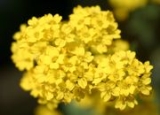
Aurinia saxatilis
Encyclopedia
Aurinia saxatilis is an ornamental plant
native to Asia
and Europe
.
This is a little, rounded, evergreen perennial that can grow from 4 to 12in high, performing a mound up to 16-20in across. the plants flowers are clear yellow, but the various cultivars produce flowers in white, cream, lemon or reach gold. Since its natural habitat is rocky, mountainous country, it is ideal for a rock garden, for dry, sloping ground, or for edging garden beds, provided the drainage is excellent. It is also ideally suited for troughs and the edges of large pots, perhaps containing a shrub. Although golden dust is a perennial, some gardeners grow is as part of an annual spring display.
Conditions
Aspects: Needs an open position in full sunlight
Site: Soil must contain plenty of chalk, sand or grit, and be free draining but not rich.
Grows readily from seed sown in the fall. Cultivars can be grown from tip cuttings taken in late spring and early summer. Space the plants about 4in apart, giving them plenty of growing room. Aurinia is sold among the alpines at garden centers.
Feeding:
Small amounts only of complete plant food may be given in early spring as a boost, but feeding is not essential.
Problems:
No specific problems are known besides poor drainage. Over watering pot-grown specimens can quickly rot and can kill the plants
Flowers appear from mid-to late spring, the flowers completely covering the plant and hiding the foliage.
Cutting:
The flower are not suitable for picking.
It is probably easier to shear radically over the whole plant with clippers, unless you are waiting for the seeds to ripen. Shearing the plant also helps to keep a compact, neatly rounded shape.
Ornamental plant
Ornamental plants are plants that are grown for decorative purposes in gardens and landscape design projects, as house plants, for cut flowers and specimen display...
native to Asia
Asia
Asia is the world's largest and most populous continent, located primarily in the eastern and northern hemispheres. It covers 8.7% of the Earth's total surface area and with approximately 3.879 billion people, it hosts 60% of the world's current human population...
and Europe
Europe
Europe is, by convention, one of the world's seven continents. Comprising the westernmost peninsula of Eurasia, Europe is generally 'divided' from Asia to its east by the watershed divides of the Ural and Caucasus Mountains, the Ural River, the Caspian and Black Seas, and the waterways connecting...
.
This is a little, rounded, evergreen perennial that can grow from 4 to 12in high, performing a mound up to 16-20in across. the plants flowers are clear yellow, but the various cultivars produce flowers in white, cream, lemon or reach gold. Since its natural habitat is rocky, mountainous country, it is ideal for a rock garden, for dry, sloping ground, or for edging garden beds, provided the drainage is excellent. It is also ideally suited for troughs and the edges of large pots, perhaps containing a shrub. Although golden dust is a perennial, some gardeners grow is as part of an annual spring display.
Conditions
Aspects: Needs an open position in full sunlight
Site: Soil must contain plenty of chalk, sand or grit, and be free draining but not rich.
Growing methods
Propagation:Grows readily from seed sown in the fall. Cultivars can be grown from tip cuttings taken in late spring and early summer. Space the plants about 4in apart, giving them plenty of growing room. Aurinia is sold among the alpines at garden centers.
Feeding:
Small amounts only of complete plant food may be given in early spring as a boost, but feeding is not essential.
Problems:
No specific problems are known besides poor drainage. Over watering pot-grown specimens can quickly rot and can kill the plants
Flowering
Season:Flowers appear from mid-to late spring, the flowers completely covering the plant and hiding the foliage.
Cutting:
The flower are not suitable for picking.
After Flowering
Requirements:It is probably easier to shear radically over the whole plant with clippers, unless you are waiting for the seeds to ripen. Shearing the plant also helps to keep a compact, neatly rounded shape.

